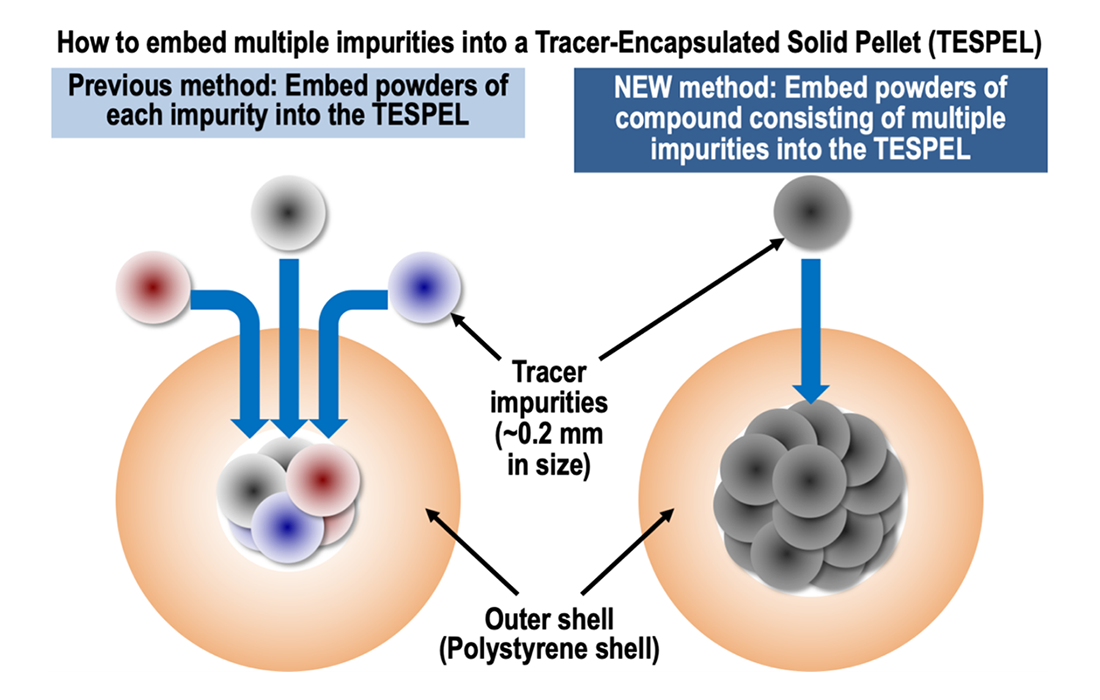A new method for simultaneously injecting different impurities into the plasma
In a tracer-capsulated solid pellet (TESPEL) scheme, which is a technique for locally depositing impurities to the desired location in high-temperature plasmas, we have developed a new method for injecting multiple impurities, which is completely different from a previous method. This achievement will greatly advance the research on the control of impurities in fusion plasmas.

In a tracer-capsulated solid pellet (TESPEL) scheme, which is a technique for locally depositing impurities to the desired location in high-temperature plasmas, we have developed a new method for injecting multiple impurities, which is completely different from the previous method. This achievement will greatly advance the research on the control of impurities in fusion plasmas.
One of the important research issues for the realization of a nuclear fusion reactor is the control of impurities in high-temperature plasmas. The impurities are penetrated the high-temperature plasma, and then are immediately ionized. The impurity ions absorb the energy of the plasma and then emit part of the energy as light. So, when the impurity ions are mixed in the plasma, the temperature of plasma will decrease. Therefore, to sustain the fusion reaction for a sufficiently long time in the fusion reactor, the plasma temperature must be maintained as high as possible, and the number of impurities in the high-temperature plasma must be kept as small as possible.
To establish a control method to minimize the number of impurities in the high-temperature plasmas, it is necessary to fully understand how impurities behave in this environment. For this purpose, our research group has been developing a technology for locally depositing impurities to a desired location in the high-temperature plasma, a tracer-encapsulated solid pellet (TESPEL).
Our research group has developed various types of TESPELs so far. One of them is capable of injecting multiple impurities into the high-temperature plasma simultaneously. This can be done by embedding powders of each impurity to be injected in a polystyrene shell (the typical size of the powder is about 0.1 mm to 0.2 mm in size). In the newly developed TESPEL, a compound consisting of multiple impurities to be injected is embedded in the polystyrene shell. This configuration enables not only the simultaneous injection of multiple impurities into the high-temperature plasma but also the injection of impurities with low atomic numbers (e.g., nitrogen and oxygen) into the high-temperature plasma as the TESPEL, which was previously impossible.
A proof-of-principle experiment with the newly developed TESPEL has been performed successfully, and thus it was found that the behavior of each impurity embedded in the newly developed TESPEL can be precisely investigated. To be used in a real experiment for the study of impurity transport in the high-temperature plasmas, it is necessary to develop a polystyrene shell that can contain a sufficient number of compounds consisting of multiple impurities to be injected. Such a polystyrene shell is developable with current technology. At present, the research for determining the physical mechanism governing the behavior of impurities based on their dependence on atomic number is being performed around the world, and this achievement can accelerate the progress of such research.
This work was supported by the JSPS KAKENHI "Verification of the robustness of methods to prevent impurity accumulation using a compound-tracer encapsulated solid pellet" (JP19H01881) and was performed by the research group of Drs. Naoki Tamura, Mikirou Yoshinuma, and Katsumi Ida at NIFS in collaboration with Dr. Xianghui Yin at the University of South China.
The research achievement was published in Review of Scientific Instruments, a journal of the American Institute of Physics, on June 16, 2021.
Publication
- N. Tamura et al., "A new multi-tracer injection pellet injection for a simultaneous study of low- and mid/high-Z impurities in high-temperature plasmas", Review of Scientific Instruments 92 (2021) 063516. [NIFS Repository]
Glossary
Tracer-encapsulated solid pellet (TESPEL):
A kind of impurity pellet (tiny grain) has been developed at the National Institute for Fusion Science to locally deposit impurities to the desired location in high-temperature plasma. It has a double-layered structure: the outer part is made of polystyrene resin consisting only of hydrogen and carbon, and the inner part is made of impurities that are being studied. For more information, please visit here.
